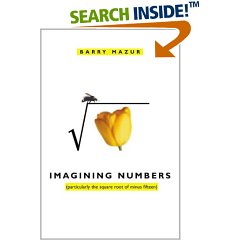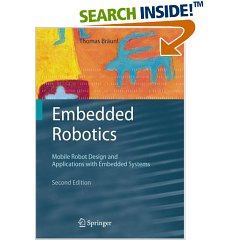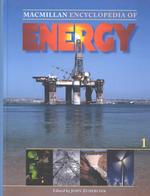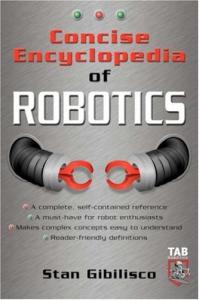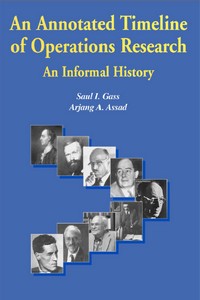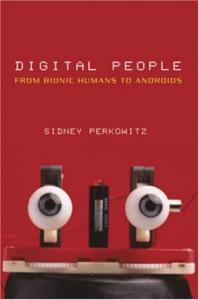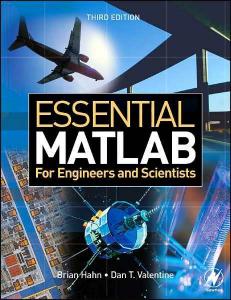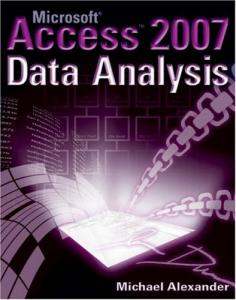Imagining Numbers May 2, 2007
Posted by admin in Miscellaneous.add a comment
Imagining Numbers
Imagining Numbers By Barry Mazur
Penguin Books Ltd | ISBN: 0374174695 | Year:2004 | 288 pages | djvu | 2.6 MB
“A clear, accessible, beautifully written introduction not only to imaginary numbers, but to the role of imagination in mathematics.” – George Lakoff, Professor of Linguistics, University of California, Berkeley.
“This absorbing and in itself most imaginative book lies in the grand tradition of explanations of what mathematical imagination is–such as those of Hogben, Kasner and Newman, and Polya’s How to Solve It. But it is unique in its understanding of and appeal to poetic thought and its analogues, and will appeal particularly to lovers of literature.”-John Hollander
“A very compelling, thought-provoking, and even drmataic description of what it means to think mathematically.”-Joseph Dauben, Professor of History and History of Science, City University of New York
“Barry Mazur’s Imagining Numbers is quite literally a charming book; it has brought even me, in a dazed state, to the brink of mathematical play.”
Embedded Robotics: Mobile Robot Design and Applications with Embedded Systems May 2, 2007
Posted by admin in Miscellaneous.add a comment
Embedded Robotics: Mobile Robot Design and Applications with Embedded Systems
Embedded Robotics: Mobile Robot Design and Applications with Embedded Systems
by Thomas Bräunl
Springer; 2nd Edition | ISBN: 3540343180 | July 2006 | PDF | File Size: 4.8 MB
This book presents a unique combination of mobile robots and embedded systems, from introductory to intermediate level. It is structured in three parts, dealing with embedded systems (hardware and software design, actuators, sensors, PID control, multitasking), mobile robot design (driving, balancing, walking, and flying robots), and mobile robot applications (mapping, robot soccer, genetic algorithms, neural networks, behavior-based systems, and simulation). The book is written as a text for courses in computer science, computer engineering, IT, electronic engineering, and mechatronics, as well as a guide for robot hobbyists and researchers.
About the Author:
Bräunl is Associate Professor at the University of Western Australia, Perth, where he founded and directs the Mobile Robot Lab and is also Director of the Centre for Intelligent Information Processing Systems (CIIPS). Professor Bräunl received a Diploma in Informatics in 1986 from Univ. Kaiserslautern, an MS in Computer Science in 1987 from the University of Southern California, Los Angeles, and a PhD and Habilitation in Informatics in 1989 and 1994, respectively, from Univ. Stuttgart. He has worked in the past for BASF and DaimlerChrysler and has founded a company for innovative mobile robot design. Professor Bräunl’s research interests are robotics, vision, graphics, and concurrency. He is author of several research books and textbooks and has developed the EyeBot mobile robot family.
Macmillan Encyclopedia of Energy (3 Volume Set) May 2, 2007
Posted by admin in Miscellaneous.add a comment
Macmillan Encyclopedia of Energy (3 Volume Set)
Macmillan Encyclopedia of Energy (3 Volume Set) by John Zumerchik
MacMillan Reference Books (December 2000) | ISBN: 0028650212 | 1500 Pages | PDF | 27 Mb
With much media attention on the energy problems in California and the current debate on U.S. energy policy, this three-volume set is a timely contribution to this subject. This work takes an interdisciplinary approach to the study of energy, offering 253 articles representing the fields of physics, chemistry, biology, economics, and ethics. The articles, which range in length from two to 20 pages, were contributed by international scientists and educators. Traditional fuels such as gasoline and diesel are covered, as are alternative fuels such as methanol and hydrogen, alternative fuels for vehicles such as hybrid and electric cars, and alternative energy sources such as wind, solar, and fuel cells. Topics also include energy concepts such as electricity, thermodynamics, combustion, and catalysts, with basic formulas for essential physical and chemical processes. In addition, there are 60 biographies of scientists and engineers who made major contributions to the understanding of energy and energy technologies, among them Rudolph Diesel, Enrico Fermi, Pierre Laplace, and Alessandro Volta. The text features numerous photographs, illustrations, sidebars, and easy-to-use charts and graphs. All articles include bibliographies, and Volume 3 contains an energy time line and a good index. Bits and pieces of similar information can be found in the Encyclopedia of Environmental Science (LJ 2/15/01), but overall this is a unique resource. Aimed at public, high school, and undergraduate libraries, it should be purchased if funds and interest are sufficient. Eva Lautemann, Georgia Perimeter Coll. Lib., Clarkston
Concise Encyclopedia of Robotics May 2, 2007
Posted by admin in Science books.add a comment
Concise Encyclopedia of Robotics
S. Gibilisco ,”Concise Encyclopedia of Robotics ”
TAB Books | ISBN / ASIN:0071410104 | 2002 | 365 pages | PDF | 1.6MB
This well-written book is not an introduction to robotics–there is no “history” article, and no article titled “Robot” or “Robotics”–but it is likely to be a useful reference for students and hobbyists. Summing Up: Recommended.
Robotics contains elements of mechanical engineering, electrical engineering, and computer science. One of the challenges in reading a robotics text or entering the field as a hobbyist is the variety of concepts and terminology one must know. This book, a “how things work” for the robotics field, provides about 400 brief articles explaining concepts from “acoustic proximity sensor” to “zooming.” Some entries are very short; “Guidance System,” for example, requires only two sentences and refers to other articles. A longer article like “Logic Gate” is a page and a half long, including a diagram and table. Most topics are technical, but some are philosophical, such as “Jungian World Theory.”
Principles of Macroeconomics by N. Gregory Mankiw May 2, 2007
Posted by admin in Miscellaneous.add a comment
Principles of Macroeconomics by N. Gregory Mankiw
Principles of Macroeconomics (with Xtra!) by N. Gregory Mankiw (Author)
Publisher: South-Western College Pub; 3 edition (February 26, 2003) | ISBN-10: 0324171897 | PDF | 5 Mb | 150 pages
In writing this textbook, Mankiw has tried to put himself in the position of someone seeing economics for the first time. The author’s conversational writing style is superb for presenting the politics and science of economic theories to tomorrow’s decision-makers. Because Mankiw wrote it for the students, the book stands out among all other principles texts by intriguing students to apply an economic way of thinking in their daily lives. Receiving such a praise as “perhaps the best ever” textbook in economic principles, it’s no wonder Mankiw’s prize project has quickly become one of the most successful books ever to be published in the college marketplace.
password : http://www.avaxhome.ru
An Annotated Timeline of Operations Research: An Informal History (International Series in Operations Research and Management Science) May 2, 2007
Posted by admin in Medical books.add a comment
An Annotated Timeline of Operations Research: An Informal History (International Series in Operations Research and Management Science)
An Annotated Timeline of Operations Research: An Informal History (International Series in Operations Research and Management Science)
211 pages | Springer | English | ISBN-10: 1402081162 | RAR&PDF | 9.60/11.28 MB
An Annotated Timeline of Operations Research: An Informal History recounts the evolution of Operations Research (OR) as a new science – the science of decision making. Arising from the urgent operational issues of World War II, the philosophy and methodology of OR has permeated the resolution of decision problems in business, industry, and government. The Timeline chronicles the history of OR in the form of self-contained, expository entries. Each entry presents a concise explanation of the events and people under discussion, and provides key sources where further relevant information can be obtained. In addition, books and papers that have influenced the development of OR or helped to educate the first generations of OR academics and practitioners are cited throughout the book. Starting in 1564 with seminal ideas that form the precursors of OR, the Timeline traces the key ideas and events of OR through 2004. The Timeline should interest anyone involved in OR – researchers, practitioners, academics, and, especially, students – who wish to learn how OR came into being. Further, the scope and expository style of the Timeline should make it of value to the general reader interested in the development of science and technology in the last half of the twentieth century.
password : http://www.avaxhome.ru
Computational Inverse Techniques in Nondestructive Evaluation May 2, 2007
Posted by admin in Miscellaneous.add a comment
Computational Inverse Techniques in Nondestructive Evaluation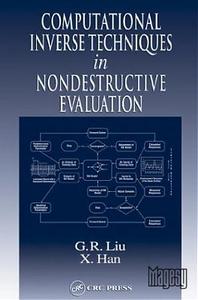
Computational Inverse Techniques in Nondestructive Evaluationy
592 pages | CRC | English | ISBN-10: 0849315239| RAR&PDF | 11.44/18.66 MB
Although many books on inverse problems already exist, they can be quite mathematical in nature and pay little attention to practical applications. This book forms a bridge between the theoretical foundations and practical applications of nondestructive evaluation methods. With unique emphasis on inverse problems in solid mechanics, it describes in detail the principles, computational methods and algorithms, and practical techniques of inverse analyses using elastic waves and dynamic responses in solids and structures. Applications of advanced computational inverse techniques to electronic system, MEMS, life science and nanotechnology are also introduced. The author also presents a new, “total solution” method for formulating engineering problems and a new regularization method proven very effective for computational implementation.
password : http://www.avaxhome.ru
Digital People: From Bionic Humans to Androids May 2, 2007
Posted by admin in Miscellaneous.add a comment
Digital People: From Bionic Humans to Androids
‘ Digital People: From Bionic Humans to Androids’
Joseph Henry Press | Pages:238 | ISBN / ASIN:0309089875 | 4.8MB
Robots, androids, and bionic people pervade popular culture, from classics like Frankenstein and R.U.R. to modern tales such as The Six Million Dollar Man, The Terminator, and A.I. Our fascination is obvious – and the technology is quickly moving from books and films to real life. In a lab at MIT, scientists and technicians have created an artificial being named COG. To watch COG interact with the environment – to recognize that this machine has actual body language – is to experience a hair-raising, gut-level reaction. Because just as we connect to artificial people in fiction, the merest hint of human-like action or appearance invariably engages us.
Digital People examines the ways in which technology is inexorably driving us to a new and different level of humanity. As scientists draw on nanotechnology, molecular biology, artificial intelligence, and materials science, they are learning how to create beings that move, think, and look like people. Others are routinely using sophisticated surgical techniques to implant computer chips and drug-dispensing devices into our bodies, designing fully functional man-made body parts, and linking human brains with computers to make people healthier, smarter, and stronger.
In short, we are going beyond what was once only science fiction to create bionic people with fully integrated artificial components – and it will not be long before we reach the ultimate goal of constructing a completely synthetic human-like being.
It seems quintessentially human to look beyond our natural limitations. Science has long been the lens through which we squint to discern our future. Although we are rightfully fearful about manipulating the boundaries between animate and inanimate, the benefits are too great to ignore. This thoughtful and provocative book shows us just where technology is taking us, in directions both wonderful and terrible, to ponder what it means to be human.
Essential MATLAB for Engineers and Scientists, Third Edition May 2, 2007
Posted by admin in Miscellaneous.add a comment
Essential MATLAB for Engineers and Scientists, Third Edition
Brian Hahn / Dan Valentine, «Essential MATLAB for Engineers and Scientists, Third Edition»
Newnes | ISBN-10: 0750684178 /ISBN-13: 9780750684170 | 3 edition (March 8, 2007) | PDF | 3 Mb | 448 pages
The essential guide to MATLAB as a problem solving tool
This text presents MATLAB both as a mathematical tool and a programming language, giving a concise and easy to master introduction to its potential and power. Stressing the importance of a structured approach to problem solving, the text gives a step-by-step method for program design and algorithm development. The fundamentals of MATLAB are illustrated throughout with many examples from a wide range of familiar scientific and engineering areas, as well as from everyday life.
Features:
Includes MATLAB Version 7.2, Release 2006a
Numerous simple exercises provide hands-on learning of MATLABs functions
A new chapter on dynamical systems shows how a structured approach is used to solve more complex problems.
Common errors and pitfalls highlighted
Concise introduction to useful topics for solving problems in later engineering and science courses: vectors as arrays, arrays of characters, GUIs, advanced graphics, simulation and numerical methods
Text and graphics in four colour
Extensive instructor support
Essential MATLAB for Engineers and Scientists is an ideal textbook for a first course on MATLAB or an engineering problem solving course using MATLAB, as well as a self-learning tutorial for students and professionals expected to learn and apply MATLAB for themselves.
Additional material is available for lecturers only at http://textbooks.elsevier.com. This website provides lecturers with:
# A series of Powerpoint presentations to assist lecture preparation
# Extra quiz questions and problems
# Additional topic material
# M-files for the exercises and examples in the text (also available to students at the books companion site)
# Solutions to exercises
# An interview with the revising author, Daniel Valentine
Numerous simple exercises give hands-on learning
A chapter on algorithm development and program design
Common errors and pitfalls highlighted
Concise introduction to useful topics for solving problems in later engineering and science courses: vectors as arrays, arrays of characters, GUIs, advanced graphics, simulation and numerical methods
A new chapter on dynamical systems shows how a structured approach is used to solve more complex problems.
Text and graphics in four colour
Extensive teacher support on http://textbooks.elsevier.com: solutions manual, extra problems, multiple choice questions, PowerPoint slides
Companion website for students providing M-files used within the book
Microsoft Access 2007 Data Analysis May 2, 2007
Posted by admin in Application books.add a comment
Microsoft Access 2007 Data Analysis
Michael Alexander, «Microsoft Access 2007 Data Analysis»
Wiley | ISBN 0470104856 | 2007-03-26 | PDF | 5 Mb | 519 pages
Book Description:
* Data analysis is the process of categorizing data into groups, translating large amounts of data into meaningful information, and performing a wide variety of calculations in a fraction of the time it would normally take by hand
* Showing readers how to save time and increase productivity, this unique book explains how to analyze data using the latest version of Microsoft Access, the world’s leading PC database system
* Practical, real-world scenarios demonstrate the benefits of using Access for data analysis, show how to avoid common pitfalls of everyday data crunching, and illustrate the differences and similarities between Access and Excel data analysis
* Explains how to analyze large amounts of data and report findings in an easily understood manner, automate redundant analysis, and get better visibility into data from different perspectives
